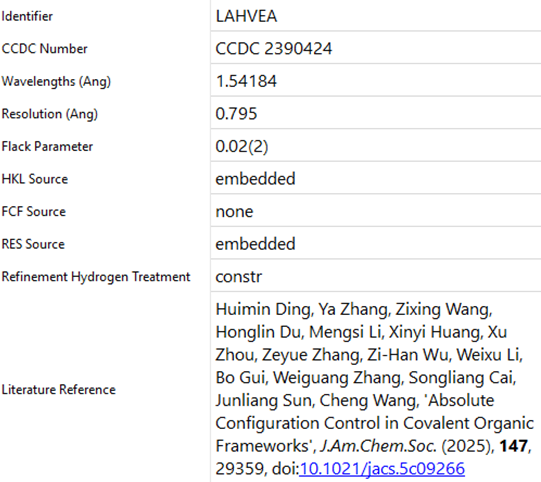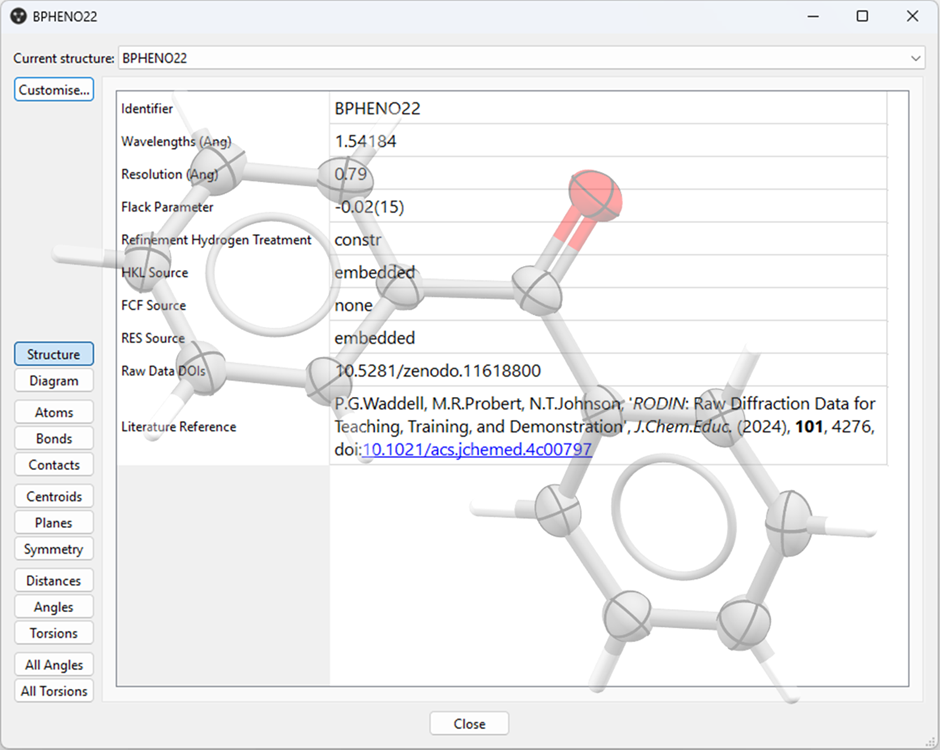Wavelength, Resolution, Flack Parameter, and Data Availability Indicators – New CSD Data Fields
We are very pleased to announce the introduction of further data fields for Cambridge Structural Database (CSD) entries. Building on the new fields previously added, this new release of the CSD (6.01) continues our mission to support the crystallographic community and provide tools to help identify entries of interest.
The new fields include Wavelength, Resolution, Flack Parameter and Data Availability indicators. The fields can be displayed for entries in Mercury and the CSD Python API, and can also be searched through the CSD Python API.
Further Experimental and Refinement Information
We have started adding wavelength to entries within the CSD to allow users to better appreciate the radiation source used in the diffraction experiment. In CSD 6.01, 743,510 entries now contain a wavelength, in Angstroms. Entries added to the CSD in 2013 or before will be updated for the next full database release in 2026 to provide a comprehensive picture of the different radiation sources used for CSD entries.
Alongside wavelength we are also adding resolution in Angstroms. This metric is a powerful indicator of data quality and precision, with lower resolution values corresponding to higher-quality data and finer structural detail, allowing more accurate determination of atomic positions, bond lengths, and angles. Provided that a CIF contains both wavelength and max theta values, a resolution will be calculated for entries. In this release, 663,865 entries have been updated with resolution and we also expect this coverage to increase when we add further wavelengths for older entries.
The Flack parameter, a measure of absolute configuration of a structure, has now been added to entries (208,373 entries). In the first instance, this parameter has been added to entries when present in the CIF without curation or validation. Further work in this area will be to allow filtering of entries with potentially erroneous Flack parameters and/or indicate where there is ambiguity to the Flack value in an entry.
Other additions to the desktop software include information about hydrogen refinement, hydrogen treatment (1.06 million entries), with over 30,000 entries with freely refined hydrogen atoms now easily identifiable. A further field populated during entry curation – refinement details – has also now been added to CSD Python API to increase searchability. We use this field to indicate refinement types such as Hirshfeld Atom Refinement (HAR), and exposing this in the API allows users more flexibility in identifying such structures.


Data Availability
To increase transparency on what the CSD contains, we’ve also added new fields around data availability. These currently cover whether or not there is an accessible hkl (reflection data), res (refinement results) or fcf (structure factor) file. The presence of these files will help users judge the quality of a structure and aids the reproducibility of entries.
These files can either be found in the CIF (“Embedded”) or as a separate file (“External”) and these options can be related to options in downloading files from WebCSD or Access Structures. In some cases, we might have instances where the additional data is available both within the CIF and as a separate file, in which case the source file will be described as “Embedded and external.” In the current release, around 545,000 entries contain an hkl file, 498,400 entries with a res file and 102,200 entries with an fcf file.
Currently these fields are displayed in Mercury as an indication of data availability and in the future we plan to make this information more immediately useful by linking entries in Mercury to WebCSD, to enable easier / quicker download files. This information can also be accessed by the CSD Python API.

The CSD also contains external links to raw data, which were previously available for entries on WebCSD, where a depositor has provided a repository link during deposition. The availability of raw data further increases transparency in the collected experimental data and this resource is invaluable for teaching X-ray crystallography solving and refinement. In this release, we’re further exposing these external links in Mercury and the CSD Python API to allow users more flexibility in locating and exploring these resources. For further information on the motivation in sharing raw X-ray crystallographic data, see RODIN: Raw Diffraction Data for Teaching, Training, and Demonstration .
Publication Titles
On top of the additional experimental and availability information added to entries, we’ve also completed population of publication titles for CSD entries associated with a resolvable DOI. This means that 1.26 million entries now have a publication title with 551,100 unique titles available through the CSD. This provides the community with some context of the published investigation without leaving the CSD entry and also a further tool to identify structures that might interest you through the searching of this field.
Publication titles can be displayed in Mercury for individual entries within the “Literature Reference” Structure Information window. They are also included in the CSD Python API where they can be printed within the Entry module of a structure and searchable through the Search module.

Next Steps
Interested in new fields being added to the CSD? Get in touch, and we will take them into consideration for the next round of data field addition.